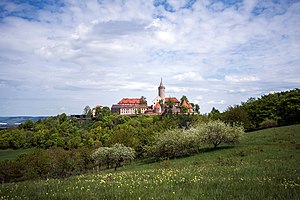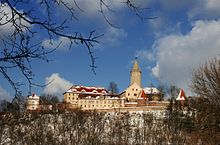Leuchtenburg (Seitenroda)
| Leuchtenburg | ||
|---|---|---|
|
The Leuchtenburg (2015) |
||
| Creation time : | First mentioned in 1221 | |
| Castle type : | Hilltop castle | |
| Conservation status: | Received or received substantial parts | |
| Place: | Side roda | |
| Geographical location: | 50 ° 48 '14 " N , 11 ° 36' 44" E | |
| Height: | 395 m above sea level NN | |
|
|
||
The Leuchtenburg is a hilltop castle near Seitenroda in Thuringia . The restored medieval castle is used by tourists and hosts the exhibition porcelain worlds Leuchtenburg , a museum and as a part of a modern cultivation a projecting valley walk web of desires Castle granted on a highly visible mountain peak with a height of 395 m above sea level. NN a wide panoramic view of the Middle Saale valley and the Thuringian woodland. The Leuchtenburg is known as the "Queen of the Saale Valley". In its long and eventful history, the castle complex was the medieval official residence, poor house, madhouse and prison and has been used for tourism since the end of the 19th century. It has been managed by the Leuchtenburg Foundation since 2007 .
history
The name of the castle goes back to the surrounding light, not forested mountain. Together with the neighboring Pfaffenberg and the Dohlenstein, it forms a mountain of three distinctive Muschelkalk hardlings.
The fortress in changing hands
The castle was first mentioned in a document on April 15, 1221, when Hartmann IV von Lobdeburg -Leuchtenburg settled a legal dispute in Dornburg . In addition to the Lobdeburg , the Leuchtenburg, about 10 km away, became the most important base for the Lords of Lobdeburg on their advance to the southeast and to the upper Saale. In the second half of the 13th century the castle was significantly expanded.
The financially ruining struggles with the bailiffs of Gera over the legacy of the Lobdeburg line at Arnshaugk Castle, which died out in 1289, were serious in the years 1314 to 1320. As early as 1313, the lords of Lobdeburg, who had become heavily in debt, had to pass the Leuchtenburg to the Counts of Schwarzburg pledge. Around 1314/17 they sold the Schleiz rulership they had founded, and in 1333 finally also the Leuchtenburg, as well as Lobenstein Castle , the Rabsburg in Zeitzgrund , and the towns of Stadtroda and Kahla .
After the Black Burgers were weakened by the Thuringian counts feud , the Wettins succeeded in conquering the castle in 1392 and, in the Leipzig Treaty in 1396, forcing the Black Burgers to finally sell the castle to them. Under the Wettins, the castle became the seat of the office for the administration of about 20 Wettin villages in the area in 1396, in the sub-offices of Leuchtenburg, Roda and Orlamünde. In the Saxon Fratricidal War (1446-1451) Duke Wilhelm III pledged . the castle to his court master Apel Vitzthum , which attracted the hatred and disfavor of Elector Friedrich II . When, after the end of the war he had fanned, Vitzthum developed in league with his brothers Busso and Bernhard into the notorious robber baron and "fire chief of Thuringia", the Saxon dukes, together with the cities of Erfurt , Sangerhausen , Mühlhausen and Nordhausen and the surrounding nobles , undertook the siege and Conquest of a number of Vizthume castles, including the Leuchtenburg, until the brothers surrendered in December 1451.
In 1460 the defense system with four defense towers was built. The castle chapel was first mentioned in 1489 . After the defeat of Elector Johann Friedrich the Magnanimous in the Schmalkaldic War in 1547, the castle served as a refuge for Electress Sibylle and her children. In 1553, the castle well , which had dried up at that time, was expanded to 80 m depth, making it the second deepest well in Thuringia at the time. During the Thirty Years' War 1618–1648, the castle was then a frequently used place of refuge.
Breeding and madhouse
In 1705 the administration of the Leuchtenburg office was relocated to Kahla. Part of the castle was then used as a breeding , poor and madhouse . In the course of the division of states under the Ernestines , the castle fell to the Duchy of Saxony-Gotha-Altenburg in 1724 . From 1724 to 1848 a total of 3588 people were kept at the Leuchtenburg, namely 3025 convicts, 115 poor and 448 so-called lunatics , the latter again being differentiated into "stupid" (in the period 1724-1824 there were 87 men and 15 women), "Crazy" (159 men, 94 women) and "mad" (13 men, 3 women). In 1826, the Leuchtenburg fell to Sachsen-Altenburg (later the Free State of Sachsen-Altenburg ), where it remained until 1920.
The " mentally ill " were taken over to Stadtroda in the newly founded ducal convalescent house in 1848 . The prison was closed in 1871 and the last prisoners were moved to Zeitz .
Museum and restaurant
After that, part of the Leuchtenburg was temporarily used as a hotel (1873–1951) and as a restaurant to this day. Since 1906 the castle has also housed a museum (initially only in the gate building), which was enlarged in several stages. The collection of the Kahla History and Antiquity Association was initially presented in the gatehouse, the Leuchtenburg District Home Museum was later established in the main castle and has been there ever since. In 1921, the first youth hostel in Thuringia was founded in the Torhaus. In the winter of 1920/1921, Muck-Lamberty Castle and his “Neue Schar” served as a place of residence and work. In 1951, instead of the hotel, the Geschwister Scholl youth hostel was opened, which was closed in 1997 due to outdated furnishings.
In the 1980s, during civil unrest, the Leuchtenburg was planned as an internment camp for up to 600 inmates. They should be housed in the rooms of the youth hostel, exhibition rooms and cellars. In the main building of the castle there was a conspiratorial apartment for meetings with unofficial employees of the Ministry of State Security , and a secret radio station on the top floor. In the event of war, “hostile foreigners” should also be interned at the castle.
In 2000 the historical Saale wine-growing at the foot of the castle was revived.
The Leuchtenburg Foundation was founded in 2007. The first part of the new permanent exhibition Porzellanwelten Leuchtenburg was opened in the museum in April 2014 . The exhibition was completed in March of the following year.
As the fictional "Schwanitz Castle", the Leuchtenburg was used in 2016 as a location for the television film The outgoing Schupo from the crime series Tatort . Its first broadcast in February 2017 led to a significant increase in the number of visitors to the castle. In 2016 the chapel (Leuchtenburg) received a new, modern interior design based on designs by Libeskind student Michael Brown and was ecumenically consecrated. As part of the Porzellanwelten Leuchtenburg concept , the so-called porcelain church is equipped with a lamellar curtain made of technical porcelain that extends from the floor to the ceiling. The church tradition is kept alive with the procession of the Way of the Cross and a passion play on Good Friday .
Building design
The complex consists of the rectangular core castle with the original keep from the 13th century (a 26-meter-high round tower), an administrative building built in 1665 using older structures that surrounds the tower (with two pointed arched doors from the 15th century), one attached Church from 1744-46, which also has the basement and wall parts of an older building that burned down in 1656, as well as the curtain wall with four flanking towers built on the other side of the Zwinger from around 1450, which replaced the original curtain wall in roughly the same place, and the outer bailey with two large buildings that were erected 1720–24, the former penitentiary and the workhouse one storey higher, and finally the gatehouse built in 1837–39. The system is surrounded by a "lined" ditch (lined with clay and stones) in which rainwater stood. The yard's running horizon was originally about 1.5 m lower. The original core castle had already been rebuilt and rebuilt many times in the 16th and 17th centuries, its current appearance is largely due to the new buildings after the great fires of 1602 and 1658. The new buildings from the 18th century led to a barrack-like four-wing complex grouped around a narrow inner courtyard. In the 19th century, smaller modern buildings within the complex were demolished again and the keep was provided with a conical helmet and crenellated wreath.
Leuchtenburg Foundation
The Leuchtenburg Foundation is a foundation under civil law, initiated by founder Sven-Erik Hitzer . The aim of the foundation is to promote the Leuchtenburg, i. H. the maintenance of public accessibility, the cultural revitalization and the renovation of the Leuchtenburg monument. On October 4, 2007, the foundation acquired the castle complex from the Landesentwicklungsgesellschaft Thuringia , which had owned the castle up to this point.
Web links
- Entry on Leuchtenburg near Seitenroda in the scientific database " EBIDAT " of the European Castle Institute
- Leuchtenburg
- Reign of Leuchtenburg
- Audio guide with information about the Leuchtenburg and the porcelain worlds
Individual evidence
- ↑ Fascinating facets. In: leuchtenburg.de, accessed on August 30, 2019.
- ↑ Ulrike Kaiser: Castle and Museum Leuchtenburg (= Small Art Guide . No. 2804). 1st edition. Schnell & Steiner, Regensburg 2011, ISBN 978-3-7954-6949-8 .
- ↑ Ulrike Kaiser: The Office of Leuchtenburg 1479–1705 . A regional center of Wettin sovereignty. In: Historical Commission for Thuringia (ed.): Publications of the Historical Commission for Thuringia . No. 33 . Böhlau, Cologne (among others) 2012, ISBN 3-412-20776-4 .
- ^ Gerhard Buchda : The State Hospital in Stadtroda 1848-1948 . Festschrift to commemorate the centennial of the institution. Vopelius, Jena 1948, OCLC 248182558 , p. 7 .
- ↑ Ulrike Kaiser: 100 Years of the Leuchtenburg Museum . In: Museumsverband Thüringen (Hrsg.): Thüringer Museumshefte . Vol. 15, No. 2, 2006, ZDB -ID 1335656-2 , p. 104-109 .
- ^ Anne Meinzenbach: The Porcelain Worlds Leuchtenburg: on the new permanent exhibition at the Leuchtenburg; brief outline of the history and use of the castle as a museum . In: Museumsverband Thüringen (Hrsg.): Thüringer Museumshefte . Vol. 21, No. 1. Gera 2012, p. 32-39 .
- ↑ Axel Bulthaupt : The light castle. Row: The East. Discover where you live. mdr television, October 28, 2014, 8.45 p.m.
- ↑ Anne Meinzenbach: Porzellanwelten Leuchtenburg: a castle changes its face . In: Museumsverband Thüringen (Hrsg.): Thüringer Museumshefte . Vol. 23, No. 2. Gera 2014, p. 9-13 .
- ↑ Lioba Knipping: Thuringia museum (22): Porcelain worlds tell stories on the Leuchtenburg. In: tlz.de. July 11, 2015, accessed February 3, 2016 .
- ^ Tatort - The outgoing police officer at crew united .
- ↑ Martin Schutt: «Tatort» increases the number of visitors to Leuchtenburg. (No longer available online.) In: Thüringer Allgemeine . November 6, 2017, formerly in the original ; accessed on August 30, 2019 (no mementos ). ( Page no longer available , search in web archives )
- ↑ Christian Fritzsche / Benjamin Rudolph: The Leuchtenburg near Seitenroda (Thuringia) - on the building history of the core castle , in castles and palaces , 2/2016, pp. 67–82
- ↑ 1st Thuringian Foundation Day. Certificate of appreciation for the "Leuchtenburg Foundation". (No longer available online.) In: thueringen.de. Thuringian Ministry of the Interior , August 25, 2016, archived from the original on August 25, 2016 ; accessed on November 7, 2019 .
- ↑ http://www.leg-thueringen.de/newsroom/medieninformationen/details/news/stiftung-uchtenburg-neue-eigentuemerin-der-uchtenburg/








